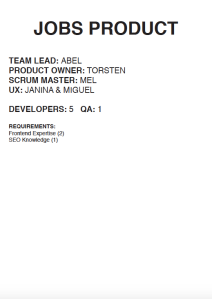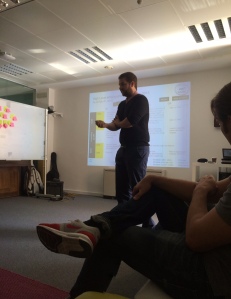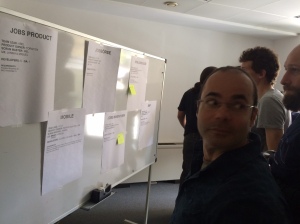Background
Change is afoot in our business unit and one of the challenges we’re facing is finding a way to accommodate new product development with the existing teams we have. In collaboration with the product team we decided to do a bit of a re-org and make 5 teams out of the 3 teams we currently have.
Inspiration: What is a Job Fair? Why hold a Job Fair?
When the subject first came up in our BLT weekly meeting I sent the leadership team these podcasts from the McCarthy Show:
In the podcasts, Michele and Jim McCarthy describe the motivation- numbing effect of traditional re-orgs at Microsoft, and what they did instead. When faced with another re-org, instead of the usual sitting in endless rounds of meetings full of political battles, they organized a job fair. If you’ve never been to a job fair, basically it is an event where companies set up brightly decorated information booths full of smiling recruiters, all trying to snap up talent. There are job fairs at colleges and universities for new graduates as well as industry or sector specific job fairs.
The job fair the McCarthys organized took a similar format and delivered the results everyone was looking for. As always their wisdom and approach is an inspiration to me. There were a few key points they made that convinced us to use a job fair format for ourselves:
Transparency
This is one value that we share here and having a job fair would be a great way to uphold that value. We would be transparent about the fact that new teams would be formed; what the teams would be working on; how many people each team would have; who the product owner, team lead, scrum master and ux for the team would be; how we would deal with conflicts over team choices.
During the actual job fair it was clear who was choosing which teams as their first and second choice. Some people used that information to make their team decisions — either choosing teams that had people they liked to work with, or passing on teams that had people they knew they didn’t want to work with.
We prepared a confluence page before-hand with some anticipated Q&A, and asked everyone to add any additional questions in the days leading up to the kick-off.
Trust
This is another core value of ours, and again the Job Fair format does a good job of supporting it. By using this format the message we wanted to send to the people was that we believe each person knows better than we do what they want to work on and with whom they want to work. Rather than pushing names around an org chart in a closed meeting room, we believed the group could put themselves in teams with minimal interference from us.
Accountability
An added benefit of being able to choose your own team is that because the choice is yours, you now are accountable to the team to make it work. It’s not so easy now to blame the other people on the team, or your manager for putting you on a team you don’t like.
Efficiency
Not counting the preparation before the job fair, the kick-off for the job fair where the POs presented their projects took 2 hours. By the end of the first day about 90% of the people had made their decision. By the next day the teams were fixed.
Product owners and team leads were available for more in depth discussions with people who wanted to find out more in order to make a decision.
Preparation
Our first challenge was getting agreement not only with the leadership team, but also the Product Owners as well as our HR business partner. Getting buy-in from the POs was simple. Our HR business partner expressed some concerns, mostly around expecting the unexpected. In the end we decided to with our gut instinct that this would work.
Next we put together the team templates. We included the following info:
- Product/Project name
- Product Owner name
- Team Lead name
- Scrum master name
- UX name
- # of devs required
- # of QA required
- any extra info about specialist knowledge; technology stack;

We prepared a confluence page with some Q&A that we thought would be asked. One week before the fair we emailed everyone announcing the event and pointing them to the confluence page.
The Day
We began the day with a half hour breakfast. Some of the product owners were relatively new and had not yet met any of the team here so we thought it would be good to start with an ice breaker.
The kick-off began with an introduction from Gemma, our VP Engineering. She again told people why we were doing this, what our expected outcome was, and general time constraints.

Each product owner was given 20 minutes to present their products/projects. Some used a PPT template that had the high level roadmap. Some preferred to talk freestyle about what the project/product was about, what they saw the challenges being, how they liked to work, and most importantly what they didn’t know yet and needed help figuring out. There was an opportunity for some Q&A after each product presentation.
Once all the presentations were done each person was given two post-its — one for their first choice and one for their second choice. People were allowed to add their post-it to a team even if the number of other post-its exceeded the total. We asked all the POs to make themselves available to answer any other questions people had about their projects.

Final Results
We held the fair on a Wednesday and our goal for the Job Fair was to have all the new team assignments finalized by the end of the same week. By the end of day Wednesday all of the 1st choice post-its had been placed, and all but 2 of the 2nd choice post-its were placed as well.
The leadership team decided to do an initial processing of the results with the POs. The majority of people got their first choice. Before sharing the final teams with everyone the team leads spoke with the people who didn’t get their first choice and made sure they were ok with their team assignments.
Feedback
After the job fair we asked people to give us feedback so that we could learn what needed to be improved. Here are some of the feedbacks we received:
Great idea of trusting the developers to pick their team! Giving employees this freedom and responsibility will lead to higher motivated employees. The new work award will not go to HR though, as they were afraid of the job fair…
Nice idea having POs showing their plans/ideas and let members to make their choice based on technical preferences, etc. Looking forward to see more of this ideas
Was really nice but I would love to see more technical talk and less product talk, a balance would be great as also developers can sell what you will be doing in the project in case you change
Retrospective
We unfortunately didn’t do a retrospective immediately after the job fair. After the retro we found some areas to improve on:
1) Transparency: how we decide final assignments. what are the new roles and dependencies for filling them. what we know/don’t know
2) PO presentations: need for preparation, need to provide similar content. need for tech perspective as well.
3) Timing: when is a good time to decide final assignments? when should we hold the next job fair? how much info do we need upfront to make it meaningful?
4) Choosing teams: only have two choices or ask people to rank all the projects in terms of preference?
Next Steps
Our next steps are to do another session to derive some action points from the open topics in the retrospective. Additionally I’m hoping to spread the word about this to our other offices and offer to help facilitate a job fair for whoever needs it.

